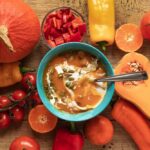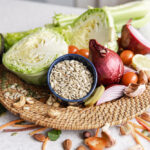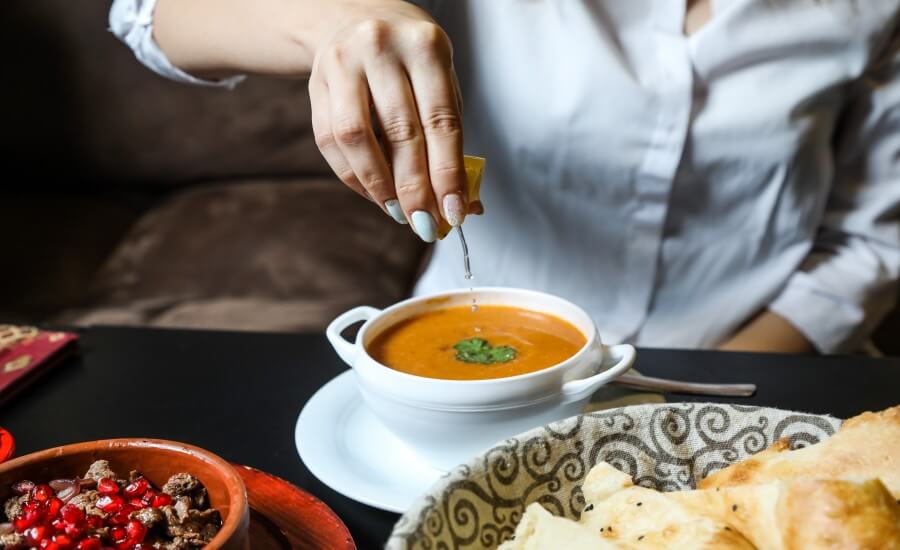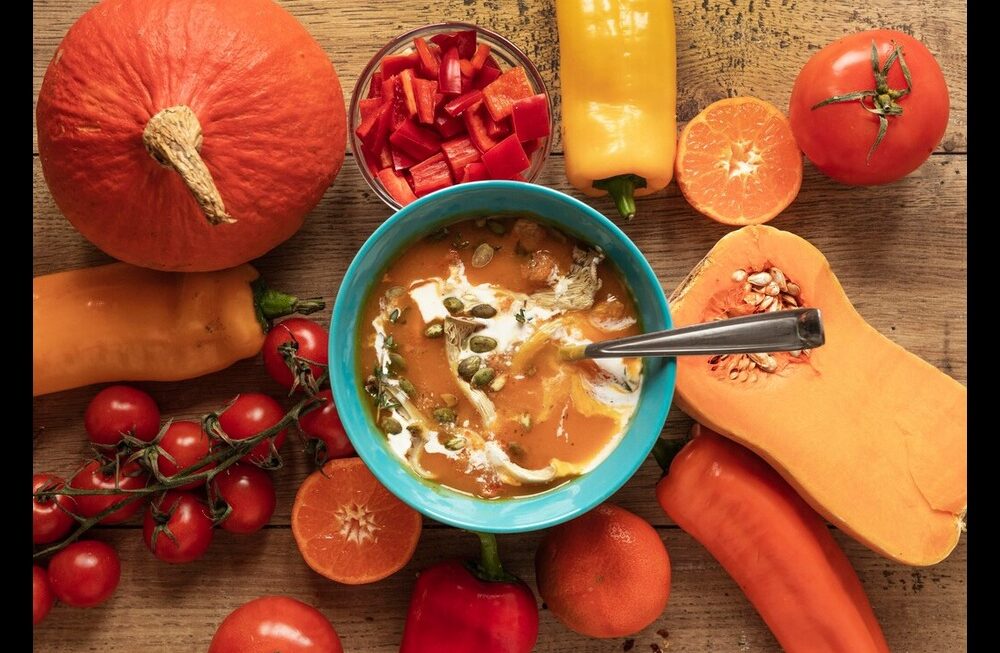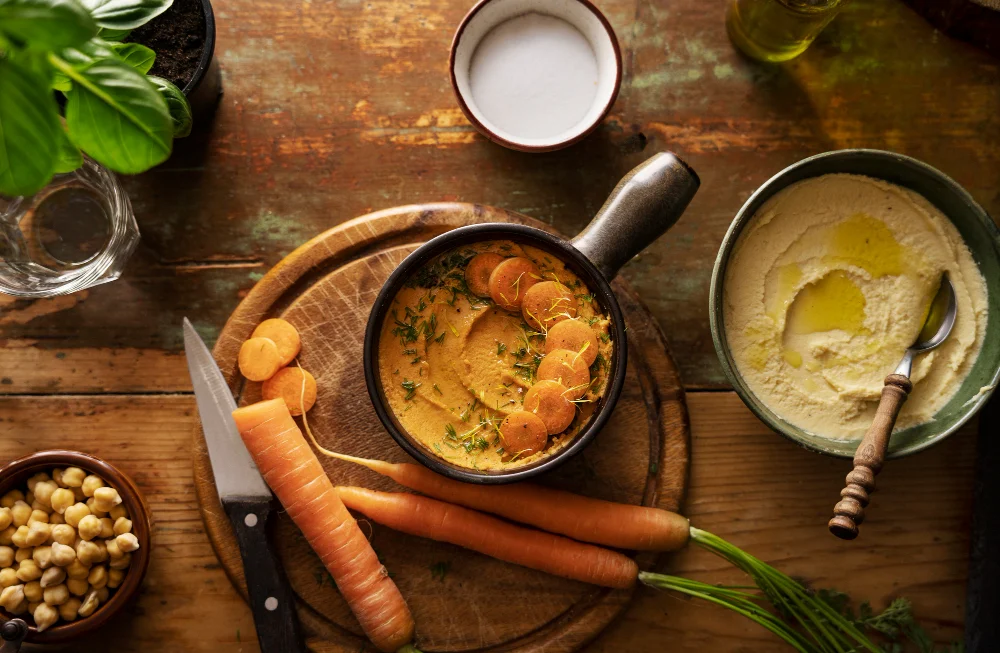Curry: the very word evokes images of aromatic spices, rich sauces, and deeply satisfying flavours. A cornerstone of Indian cuisine and beloved worldwide, curries offer incredible diversity. The wonderful news for plant-based eaters is that a vast number of traditional Indian curries are already vegan or can be easily and deliciously adapted. Moving beyond simplistic notions, this guide explores the universe of flavorful vegan curry recipes. We’ll delve into the nutritional bounty they offer, the ethical considerations behind their preparation, the environmental wisdom embedded in their ingredients, and the practical techniques needed to create authentic, mouth-watering vegan curries in your own kitchen, drawing inspiration from the rich culinary heritage of India and the seasonal landscape of Rajasthan.
LENS 1: Nutritional Analysis (Wholesome & Hearty)

Well-crafted vegan curries are often nutritional powerhouses, delivering a wealth of benefits in a single, satisfying bowl.
- Plant Protein Packed: Legumes form the heart of many Indian curries. Lentils (dals like Toor, Moong, Masoor), chickpeas (chana), kidney beans (rajma), and black-eyed peas (lobia) provide substantial protein and fiber. Tofu, tempeh, soy chunks, and even vegetables like peas (matar) further boost protein content.
- Fiber Rich: The combination of vegetables, legumes, and often whole grains served alongside (like whole wheat roti or brown rice) makes vegan curries typically very high in dietary fiber, essential for digestive health, blood sugar regulation, and satiety.
- Vitamin & Mineral Vault: The diverse vegetables used contribute a wide array of micronutrients. Leafy greens like spinach (palak) or fenugreek (methi) offer iron, calcium, and folate. Carrots (gajar) and pumpkin provide Vitamin A precursors (beta-carotene). Tomatoes are rich in Vitamin C and lycopene. Potatoes offer potassium.
- Spice Symphony Benefits: Indian spices are not just for flavour; many have purported health benefits studied for centuries in Ayurveda and increasingly in modern science. Turmeric (haldi) contains curcumin (anti-inflammatory), ginger (adrak) and garlic (lehsun) have antimicrobial and anti-inflammatory properties, cumin (jeera) and coriander (dhania) aid digestion, and chilies contain capsaicin (metabolism boosting potential).
- Healthy Fats: Richness comes from plant sources like traditional cooking oils (mustard, groundnut, coconut, sunflower – used moderately), coconut milk/cream (especially in South Indian or Korma-style dishes), or pastes made from nuts (cashew/kaju, almond/badam) and seeds (poppy/khus khus, sesame/til). These provide flavour and help absorb fat-soluble vitamins.
- Balanced Meal: A typical Indian meal of curry served with rice or roti provides a balanced combination of protein, complex carbohydrates, fats, fiber, vitamins, and minerals. Remember that Vitamin B12 needs to be obtained from fortified foods or supplements in a vegan diet. How can you increase the variety of vegetables and legumes in your favorite vegan curry for enhanced nutrition?
Nutritional Deep Dive: The Powerhouse Spices of Indian Vegan Curries
- Turmeric (Haldi): Contains curcumin, a potent anti-inflammatory and antioxidant.
- Ginger (Adrak): Aids digestion, anti-inflammatory, anti-nausea.
- Garlic (Lehsun): Cardiovascular benefits, antimicrobial properties.
- Cumin (Jeera): Aids digestion, source of iron.
- Coriander (Dhania): Aids digestion, antioxidant properties.
- Fenugreek (Methi): May help blood sugar control, adds unique flavour.
- Asafoetida (Hing): Traditionally used to aid digestion and prevent bloating from legumes.
- Black Pepper (Kali Mirch): Contains piperine, which enhances curcumin absorption and aids digestion.
- Cardamom (Elaichi), Cloves (Laung), Cinnamon (Dalchini): Warming spices with antioxidant properties, often used in garam masala.
Voice of Experience (Ayurvedic Nutritionist): “Traditional Indian vegan curries are often inherently balanced according to Ayurvedic principles. The combination of legumes or vegetables with rice/roti, the skillful use of digestive spices like cumin, coriander, ginger, turmeric, and asafoetida, and adapting ingredients to the season creates meals that nourish the body, support digestion (Agni), and balance the doshas.” – Dr. Vani Gupta, BAMS

LENS 2: Ethical Framework (Compassionate Cuisine)
Creating and enjoying flavorful vegan curries resonates deeply with ethical principles of compassion and conscious consumption.
- Kindness on the Plate: The most direct ethical benefit is enjoying complex, satisfying, rich flavours without causing harm to animals. Vegan curries stand as delicious proof that meat, dairy cream, or ghee are unnecessary for incredible taste.
- Supporting Local & Fair Practices: Choosing locally grown, seasonal vegetables for your sabzis directly supports farmers in your region, like those around Jaipur. Opting for Fair Trade certified spices ensures that the farmers growing these essential flavourings receive fair compensation and work under better conditions.
- Hospitality & Sharing: Sharing food is central to Indian culture and hospitality. Offering flavourful, homemade vegan curries during festivals, family meals, or to neighbours is a powerful way to share compassion, challenge misconceptions about vegan food, and demonstrate that traditions can evolve kindly.
- Reducing Food Waste: Curries are wonderfully adaptable for using up various vegetables you have on hand. Leftover cooked dal or sabzi can be repurposed into paratha fillings or combined into new dishes, embodying the ethical principle of minimizing waste. Using parts of vegetables often discarded (like cauliflower stems/leaves) adds to this. How does sharing a delicious homemade vegan curry feel like an act of ethical hospitality?
Hidden Benefits: Cultural Connection through Compassion
Veganizing traditional family or regional curry recipes allows individuals to stay connected to their cultural heritage and culinary identity while upholding their ethical commitment to veganism, creating a meaningful synthesis of past and present values.
Voice of Experience (Chef Specializing in Vegan Indian Cuisine): “Veganizing Indian curries isn’t about losing authenticity; it’s about finding compassionate ways to achieve those beloved flavours and textures. Using cashew cream instead of dairy for korma, blooming spices in plant oil for tadka, celebrating the richness of lentils in dal makhani – it shows respect for the tradition while aligning with modern ethics.” – Chef Rohan Agarwal, “Plant-Powered Rasoi”
Critical Reassessment: Authenticity and Accessibility
While vegan versions can be incredibly delicious, debates around “authenticity” may arise, particularly regarding the absence of ghee or traditional dairy elements. It’s important to celebrate the vegan adaptation for what it is – a delicious, compassionate evolution. Additionally, ensure recipes promote accessible ingredients, acknowledging that some specialty items or perfect produce might not be available to everyone.
LENS 3: Ingredient Science & Environment (Sustainable Spice & Simmer)

Understanding the science behind curry making and the environmental impact of ingredients helps create sustainable and delicious results.
- The Science of Flavor Building:
- Tadka/Tempering: Blooming whole and ground spices in hot oil releases their fat-soluble flavour compounds, creating the aromatic foundation of most Indian curries.
- Masala Base: Slowly cooking onions, ginger, garlic, and tomatoes breaks down cell walls, releases sugars for caramelization, and creates a complex, flavourful gravy base.
- Creaminess: Emulsifying fats (from coconut milk, blended nuts/seeds like cashew/poppy/sesame, or even blended potatoes/beans) with the water-based gravy creates rich, smooth textures.
- Acidity: Ingredients like tomatoes, tamarind (imli), yogurt alternative, or lemon juice balance richness and brighten flavours.
- Environmental Impact:
- Plant Power: Vegan curries based on legumes (dal, chana, rajma) and vegetables have a significantly lower environmental footprint (land use, water use, greenhouse gas emissions) compared to meat-based curries (chicken, mutton, fish). Legumes even enrich the soil by fixing nitrogen.
- Seasonal & Local:* Using seasonal vegetables drastically reduces food miles and the energy associated with out-of-season production (greenhouses, storage). In Rajasthan’s current hot season (May), this might mean using gourds (lauki, tori), okra (bhindi), cluster beans (guar phali), tomatoes, onions, peppers. Winter offers carrots, peas, cauliflower, spinach, mustard greens etc.
- Accompaniments: Rice cultivation is water-intensive. Pairing curries with less water-intensive grains like locally grown millets (bajra, jowar roti) can be a more sustainable choice in arid regions like Rajasthan.
- Ingredient Sourcing: Consider the footprint of ingredients like coconut milk or cashews, which may travel long distances. Using local alternatives where possible (like groundnut oil instead of imported olive oil) enhances sustainability. Could you design a vegan curry primarily using vegetables that are currently in season in your local area (like Jaipur)?
Market Transformation Map Suggestion: Data showing the increasing shelf space and sales volume dedicated to diverse types of lentils (dals) and whole spices in Indian grocery stores compared to processed foods or meat sections.
Voice of Experience (Sustainable Agriculture Expert): “India’s traditional cuisine, with its heavy reliance on diverse legumes and seasonal vegetables, is inherently quite sustainable. Promoting vegan curries that emphasize these local, low-impact staples, perhaps served with millets instead of solely rice, is a powerful strategy for both environmental health and food security, especially in regions facing climate challenges like Rajasthan.” – Dr. Meera Singh, Centre for Sustainable Agriculture
LENS 4: Everyday Practitioner’s Experience (Recipes & Techniques)

Let’s bring the flavours home with practical recipes and tips for delicious vegan curries.
Flavorful Vegan Curry Recipe Ideas (Indian Inspired):
(Adapt vegetables seasonally; adjust spices to taste)
- Everyday Dal Tadka (Yellow Lentil Soup):
- Pressure cook rinsed Toor Dal or Moong Dal with turmeric and salt until very soft.
- Prepare Tadka: Heat plant oil or vegan butter. Add mustard seeds (rai), cumin seeds (jeera). Once sputtering, add chopped garlic, dried red chili, curry leaves (optional), and asafoetida (hing). Pour tadka over cooked dal. Garnish with fresh coriander (dhania). Serve with rice or roti.
- Creamy Palak Tofu (Spinach ‘Paneer’):
- Blanch spinach (palak), then blend into a smooth puree.
- Sauté cubed firm tofu until lightly golden. Set aside.
- Sauté finely chopped onions, ginger-garlic paste. Add tomato puree, turmeric, coriander powder, chili powder, garam masala. Cook until oil separates.
- Add spinach puree and a little water/broth. Simmer. Stir in cashew cream or coconut milk for richness (optional). Add tofu cubes. Simmer briefly. Garnish with ginger juliennes.
- Chana Masala (Chickpea Curry):
- Sauté onions until golden brown. Add ginger-garlic paste, then chopped tomatoes or puree. Cook well.
- Add chana masala powder, turmeric, chili powder, coriander powder, salt. Cook spices.
- Add cooked chickpeas (canned or pressure-cooked from dried) and some water/broth. Simmer for 15-20 minutes for flavours to meld. Finish with garam masala, a squeeze of lemon juice, and fresh coriander.
- Seasonal Mixed Vegetable Sabzi (Jaipur Summer Example):
- Heat oil, add cumin seeds, hing. Sauté onions, ginger, garlic.
- Add chopped seasonal vegetables available now like bottle gourd (lauki), ridge gourd (tori), okra (bhindi – lightly fried separately first helps reduce slime), tomatoes, perhaps some potato cubes.
- Add turmeric, coriander powder, chili powder, salt. Stir well.
- Add minimal water, cover and cook until vegetables are tender-crisp. Finish with garam masala and fresh coriander. Serve with roti. (In winter, use carrots, peas, cauliflower, potatoes).
- Vegan Gatte ki Sabzi (Rajasthani Specialty Adaptation):
- Make dumplings (gatte) by kneading gram flour (besan) with spices (turmeric, chili, ajwain, hing), oil, and water into a firm dough. Roll into logs, steam or boil until cooked, then slice.
- Prepare gravy: Heat oil, add cumin/mustard seeds, hing. Sauté onion-ginger-garlic paste. Whisk vegan yogurt (thick, unsweetened) with besan and water. Add to pan with turmeric, chili, coriander powder, salt. Cook carefully, stirring constantly until gravy thickens (don’t boil rapidly if using some vegan yogurts). Add gatte slices and simmer gently. Finish with garam masala and coriander. (Requires a good vegan yogurt).
Key Curry Techniques:
- The Masala Base: Properly cooking the onion-ginger-garlic-tomato base until oil separates is crucial for deep flavour.
- Blooming Spices (Tadka/Tempering): Heating whole and ground spices in hot oil releases their full aroma and flavour potential. Can be done at the start or as a finishing garnish.
- Creaminess without Dairy: Blend soaked cashews/sunflower seeds/poppy seeds into a paste, use coconut milk/cream, blend some cooked vegetables (potato, pumpkin) or white beans into the gravy, or use a besan slurry (for dishes like kadhi or gatte).
- Pressure Cooking: Saves significant time for cooking dals and beans from dried. Follow manufacturer’s instructions.
- Garnishing: Fresh coriander (dhania), mint (pudina), ginger juliennes, or toasted nuts/seeds add freshness, texture, and visual appeal.
What technique (like tadka or making cashew cream) would most elevate your homemade vegan curries?
Daily Impact: Curry Versatility
Mastering a few basic curry gravy recipes allows for endless variation simply by changing the main vegetable or legume used, adapting easily to seasonal availability.
Voice of Experience (Indian Home Cooking Teacher): “The secret to truly flavourful Indian vegan curries lies in understanding spices and techniques. Learn to make a good tadka, properly cook your onion-tomato masala, and don’t be afraid to use spices generously but balanced. Even the simplest dal or sabzi can be extraordinary with these basics.” – Mrs. Madhu Sharma, Culinary Instructor
Alternative Approaches: Dry Curries & Global Styles
- Dry Sabzis/Bhajis: Focus on stir-frying vegetables with spices with minimal added water, allowing vegetables to cook in their own steam (e.g., Bhindi Masala, Aloo Gobi dry style).
- Global Curries: Explore vegan versions of Thai green/red curry, Malaysian Rendang, or Ethiopian wots – different spice profiles and techniques offering exciting variety.
PERSPECTIVE INTERSECTION MATRIX
- Nutrition & Spices (Lens 1 & 4): Understanding the potential health benefits of spices (Lens 1) encourages their liberal use in practical recipes (Lens 4), enhancing both flavour and well-being.
- Ethics & Local Sourcing (Lens 2 & 4): Choosing to support local farmers ethically (Lens 2) guides the practical selection of seasonal vegetables at the market for curries (Lens 4), connecting to environmental benefits (Lens 3).
- Environment & Ingredients (Lens 3 & 4): Using low-impact legumes and seasonal vegetables (Lens 3) is the core of many practical, traditional, and sustainable curry recipes (Lens 4).
- Science & Flavour (Lens 3 & 4): Understanding the science of flavour release through tadka or slow simmering (Lens 3) informs the techniques used by home cooks to achieve delicious results (Lens 4).
- Culture & Adaptation (All Lenses): Veganizing traditional Indian curries (Lens 4) involves respecting cultural flavours (Lens 1/4), making ethical choices (Lens 2), using available ingredients (Lens 3/4), and applying cooking science (Lens 3).
MISCONCEPTION ANALYSIS
| Misconception | Reality |
| Authentic, rich Indian curries must use ghee, cream, paneer, or yogurt. | While traditional, these aren’t essential for flavour depth or richness. Skillful use of plant oils, spices, aromatics, slow cooking, cashew/coconut/seed creams, and techniques like tadka create incredibly authentic and rich vegan results. |
| Vegan curries are mostly just vegetables and lack substance or protein. | Many vegan curries are based on protein-rich legumes (dal, chana, rajma) or tofu/soy chunks. Combined with vegetables and served with grains, they form complete, hearty, and satisfying meals. |
| Making flavourful Indian curry from scratch is overly complicated. | While some restaurant dishes are complex, many everyday home-style curries (dals, sabzis) rely on simple, repeatable techniques (tadka, basic masala base) and readily available spices. Pressure cookers significantly speed up legume cooking. |
| All curries are extremely spicy (hot) or heavy and unhealthy. | Heat level is adjustable by controlling chili usage. Curries can range from very light (like a simple dal or shorba) to rich (like korma). They can be made very healthy by using minimal oil and loading up on vegetables and legumes. |
| Vegan ingredients can’t replicate the texture of paneer or meat in curries. | Firm or extra-firm tofu, pressed well and often pan-fried or baked first, makes an excellent substitute for paneer (as in Palak Tofu). Soy chunks or seitan can provide a ‘meaty’ texture. |
KEY TURNING POINTS
- Global Spread of Indian Cuisine: Introduced curries worldwide, sparking interest and adaptation.
- Rise of Vegetarianism/Veganism: Led to increased demand for plant-based versions of traditionally non-veg or dairy-heavy curries (e.g., Tofu Tikka Masala replacing Chicken Tikka).
- Online Recipe Sharing: Platforms enabled widespread sharing of authentic regional Indian recipes and creative vegan adaptations (e.g., blogs like Vegan Richa).
- Increased Availability of Ingredients: Easier access globally to Indian spices, lentils, coconut milk, tofu, and vegan yogurt alternatives.
- Chef Innovation: Professional chefs creating refined, innovative plant-based Indian cuisine, elevating perceptions.
SYNTHESIS & RECOMMENDATIONS
Flavorful vegan curry recipes offer an incredible journey into a world of aromatic spices, hearty textures, and deep satisfaction, all while embracing compassionate and sustainable eating. Drawing on the rich tapestry of Indian culinary traditions and the abundance of plant-based staples, creating delicious vegan curries at home is accessible and rewarding. By mastering fundamental techniques like building a flavourful masala base and using spices effectively, utilizing seasonal produce, and exploring different legume and vegetable combinations, you can enjoy endless variety. Forget the misconception that vegan curries lack richness or authenticity – plant-based ingredients, especially when prepared with Indian techniques, deliver truly exceptional results.
Recommendations for Flavorful Vegan Curries:
- Master the Base: Learn to properly sauté onions, ginger, garlic, and tomatoes to form a rich masala gravy foundation.
- Unlock Spice Power: Invest in basic whole and ground Indian spices. Learn the art of ‘tadka’ (tempering) to bloom spices in hot oil for maximum flavour.
- Embrace Legumes: Make dals, chickpeas (chana), and beans (rajma) your protein-packed curry staples. Use a pressure cooker for speed with dried varieties.
- Cook Seasonally: Utilize fresh, seasonal vegetables available locally (check your Jaipur market!) for the best taste, price, and nutrition.
- Create Creaminess Wisely: Experiment with cashew cream, coconut milk (where appropriate), blended vegetables (potato, squash), or silken tofu for rich textures without dairy.
- Balance Flavours: Don’t forget acidity (tomato, tamarind, lemon) to cut richness, a touch of sweetness (jaggery/sugar, if needed) to balance spice, and salt to enhance all flavours.
- Garnish for Freshness: Finish with fresh coriander (dhania), mint (pudina), or ginger juliennes for brightness and appeal.
- Pair Appropriately: Serve with basmati rice, brown rice, whole wheat roti/chapati, or local breads like bajra roti for a complete meal.
FURTHER AREAS OF EXPLORATION
- A Beginner’s Guide to Essential Indian Spices & Their Uses
- Mastering Vegan Dal Makhani or Chana Masala at Home
- Techniques for Making Creamy Vegan Sauces (Cashew, Coconut, Tofu based)
- Exploring Regional Indian Vegan Curries (Bengali, South Indian, Goan etc.)
- Veganizing Traditional Rajasthani Dishes (Gatte ki Sabzi, Ker Sangri)
- Quick Vegan Curry Recipes Using Pressure Cookers
- Guide to Cooking Different Types of Indian Lentils (Dals)





